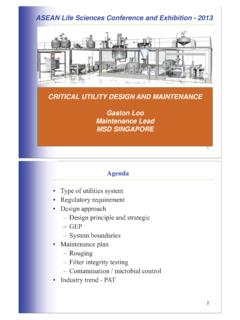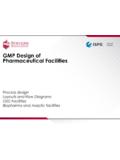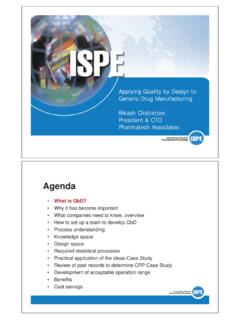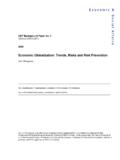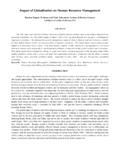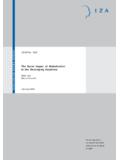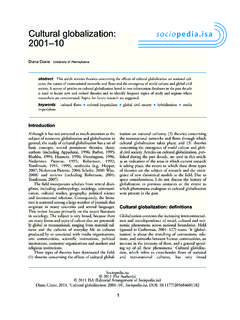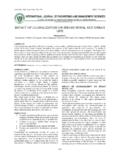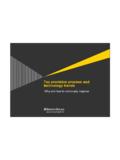Transcription of PLANNING OF PHARMACEUTICAL FACTORIES - ISPE Th
1 PLANNING OF PHARMACEUTICAL FACTORIES CONCEPT AND IMPLEMENTATION WORLD CLASS PHARMA FACILITY PRESENT SCENARIO : The globalization and open market policies have proved to be a boon for the industries, but also have generated the need for globally acceptable manufacturing facilities. There are many flourishing manufacturing facilities, but not all are in compliance with the various regulatory standards. NEED FOR A FACILITY : Rapid change in manufacturing technology & various regulatory compliances to upgrade for better solution in line with cGMP. With globalization , the need for a compliant facility has become a statutory necessity. PARTICIPANTS TO THE PLANNING PROCESS Forecasts for x years Objectives Budget Company internal approvals Technology Logistics Building services Building technology Approvals ( PHARMACEUTICAL ) Approvals (non- PHARMACEUTICAL ) PLANNING Execution Internal Planner Authorities PLANNING TEAM(S) SCHEDULE EXAMPLE Company standards, PLANNING conditions (quantities, technologies, products, deadlines, budget.)
2 Specific guidelines, (Biosafety, Fed Std, OSHA) for conception, PLANNING , operation .. Norms ISO, ATEX, Labour and environmental PHARMACEUTICAL regulations, EU, FDA, PIC/S, WHO, requirements of pharmacy inspectors, product registration .. NORMS, REGULATIONS AND REQUIREMENTS General laws + regulations Process / Equipment GMP and Hygiene Zoning Quantitative data Layout Feasibility Concept Basic Design Detail Design Execution Complete detailing for all disciplines Layouts 1:20, 1:50 Tendering Refining of elements Calculations Functional tendering Layouts 1:100 PLANNING STEPS HOAI Feasibility Concept Basic Design Detail Design Execution Conceptual design Basic Design Detail Design Execution CONVENTIONAL MODEL IMPROVED MODEL PLANNING MODELS FEASIBILITY VERSUS CONCEPTUAL STUDY Static Dominated by Economical Criteria No Project Alternatives.
3 Yes / No only No Influence on Schedule of Subsequent Phases Feasibility Includes the Feasibility Study Dynamic / prospective Dominated by Technical Criteria Project Alternatives are generated User oriented Choices possible - Costs - Technology - Organisation Reduces Time spent on subsequent Phases, while increasing their Precision Conceptual Study Strong Conceptual design Basic Design Detail Design Execution PLANNING MODELS It pays to invest into a strong conceptual design Low initial costs Early clarification of main issues Powerful decision tool Possibility to develop alternatives Freewheeling PLANNING SEQUENCE AND ITERATION PROBLEMS PLANNING Task Start Task Definition Targets Requirements Analysis Conceptional Design with Alternatives Basic Design Execution easy difficult Detail Design 100% 90% 80% 60% 50% 40% 30% 20% 10% 70% 100% RELATIVE COSTS OF THE DIFFERENT PHASES The cheapest and most promising Phase is the Conceptual Phase !
4 Detail Engineering Factory size Factory organisation Technology GMP concept Basic Design Conceptual Design Execution Cost saving potentials 100% 90% 80% 70% 60% 50% 40% 30% 20% 10% POSSIBILITIES OF COST MINIMISATION Basic Design The best and cheapest chance to minimise cost of investment and operation is in Phase 1 ! Detail Engineering Execution Costs saving potential Conceptual Design Factory size Factory organization Technology GMP Small teams Brainstorming Alternatives New ideas Feasibility Conceptual design Basic design Detail design Execution Supervision Documentation Cost estimation Cost calculation Tender documents Offers Final quotations The better the concept, the higher the precision DETERMINATION OF COSTS in relation to the PLANNING stage PRICE PAID PRECISION OF COSTS in relation to the PLANNING stage stage 30% Cost estimation Feasibility Conceptual design 5% Final Quotations Execution Supervision Documentation 20% Cost calculation Basic Design 10% Tender documents Offers Detail Design The better the concept.
5 The higher the precision Feasibility Conceptual design Basic design Detail design Execution Supervision Documentation DETERMINATION OF COSTS in relation to the PLANNING system Turnkey price: poor control General planner: good control - + The Purpose of the Conceptual Design is to arrive to Layout General Factory Organisation Procedures Hygiene Concept Technology Concept Air Handling and Utilities Concepts which can be successfully presented to Authorities for a Pre-Approval Design Review GMP Considerations and Factory PLANNING go Hand in Hand PURPOSE OF CONCEPTUAL DESIGN and to get a high degree of safety about Investments Schedule - PLANNING of a production plant future oriented flexible economical in investments and operating costs GMP conform conform to local / international regulations - High motivation of staff by high quality of working place - Efficient PLANNING - Adequate quality standard (value for)
6 Money) - Architecture compatible with local surroundings TARGETS OF PHARMACEUTICAL FACTORY PLANNING HOW TO REACH A GOOD CONCEPTUAL DESIGN RESULT ? Right team Good method Discipline Good data Some fantasy Right team Good method Discipline Good data Some fantasy Right team Good method Discipline Good data Some fantasy Right team Good method Discipline Good data Some fantasy Right team Good method Discipline Good data Some fantasy PEOPLE AND PLANNING A Quote: You do not really understand something unless you can explain it to your grandmother." Albert Einstein The idea is to work intensively with a small group of people, possibly detached from their daily chores. These people must have the necessary know-how (or back-ups) and the power of decision CORE TEAM Production Manager Quality Assurance Integrated Factory PLANNING Experts Process GMP Expert Controller AD HOC MEMBERS Utilities Specialist Other Specialists Logistics Engineering PEOPLE AND PLANNING Generalists Specialists Execution Detail Design Conceptual Design Basic Design PLANNING VALIDATION Generalists Specialists Number of people Number of people PEOPLE AND PLANNING 90% 100% 80% 70% 60% 50% 40% 30% 20% 10% Individuals Concept Team Large Organisations Judgement Errors Number of Participants Role of participants.
7 To plan AND to decide JUDGEMENT ERRORS By Experimenting and Innovating By Cloning Existing Units By Adding Individual Functions By Turnkey Contracting PLANNING METHODS There are many design methods By Systematic PLANNING Masterplan General organisation factory Site, Site selection Departments Functional groups Equipment, single units PLANNING FROM INSIDE TO OUTSIDE PLANNING FROM MACRO TO MICRO PLANNING FROM IDEAL TO REAL OPTIMAL PLANNING METHOD NEED FOR FOCUSING Economy of scale Efficiency / Best practice Flexibility Performance Organisation Analysis of Product range Process Technologies Organisation Conceptional design Make or buy Specialisation Capacity increase Technology Standardisation Regulatory aspects Results versus costs Requirements Vision of client PLANNING METHOD DEVELOPMENT OF IDEAL ORGANISATION Information Strategy Identification key problems Analysis Material / Information flow Idenfication necessary infrastructure Analysis process START Definition Modules
8 Functional units Vertical Horizontal Resulting Organisation END Verification process flow, material flow Other requirements, constraints, etc. Calculation necessary space Definition of constraints, etc. Adaptation Process, machinery + equipment Evaluation + Selection Plant strategy + Process architecture Rough layout development Layout alternatives Combination material flows functional inter-dependencies B/W-Orientation of factory Analysis organisation Analysis space situation Analysis machinery / equipment Analysis of products and production volumes Verification GMP concept Morphological Analysis + Search for Solutions Capacity and Rationalisation Analysis Existing Technology GMP-Concept Technological Alternatives Investment / Budget Forecasts, Quantities, Product Mix Batch Sizes Galenical Properties Degree of Automation Project- Technology Degree of Automation Batch Sizes Shifts ?
9 Product Seasonality Campaign Sizes Cleaning + Change-over Times Foreseen Equipment Dimension. Machines (Type/ Quantity) PLANNING METHOD RATIONALISATION, INNOVATION AND OPTIMISATION GMP-Concept Plant strategy + Process architecture PLANNING PROCEDURE: CONCEPTUAL DESIGN Development of the masterplan for the design onthe green field Development of the integration of the layout into an existing building structure Production forecasts / next 6-10 years Description of process flows from starting materials until finished product Design of the overall flow diagram indicating all GMP-classes Calculation of material flow quantities Definition of personnel, shifts, etc. Design of the ideal layouts + modules for each step Ideal layouts personnel areas Ideal layouts peripheral areas Combination of individual layouts to functional units --> Granulation, tabletting, preparation of liquids, filling.
10 Design of the ideal overall total layout Definition of - Process technology - Machinery + equipment - Transport systems + containers PLANNING PROCEDURE: CONCEPTUAL DESIGN FORECASTS Product lists, quantities Sorting by galenical forms Sorting by types ( conventional , toxic, hormones, beta-lactames, etc.) Strategy for marginal products (quantities, types, galenical forms): Make or buy ABC ANALYSIS SELECTION OF TECHNOLOGY AND EQUIPMENT EXAMPLES OF SELECTION FACTORS Vision of client Properties of products to be processed Output requirements Degree of automation, sophistication Supplier: price, service and serviceability Cleanability and maintenance needs Space constraints Previous experience, available equipment (standardization) GMP issues Safety of operator SELECTION OF TECHNOLOGY AND EQUIPMENT Vision of client: size, degree of sophistication, automated guided vehicles, architecture, budget, future-oriented or not Properties of products to be processed Output requirements Degree of automation, sophistication Supplier.
